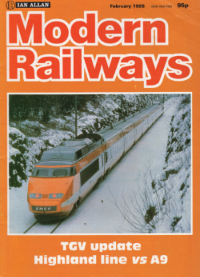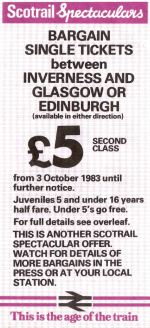


Whilst tidying up some of his working archive material, a FoFNL committee member stumbled across this uncannily relevant copy of Modern Railways magazine from nearly 40 years ago.
Firstly, the cover photo could easily be of a TGV flying along the Highland Main Line. In our dreams! The juxtaposition of the two 'cover lines' at the bottom is perfect.
Secondly, one of the cover lines refers to a long article about the Highland Main Line. It analyses in great detail the challenges faced by the railway. And here we are, nearly 40 years later, looking at the same scenario, with the added dimension of another vast sum about to be spent on improving the road, when there is no genuine business case for doing so, when it is against government modal shift policy, and when it will use money which could have been spent on improving the far safer rail alternative.
The intervening years have seen disappointingly little investment in the HML.
The basis of the 1985 article, Highland Line vs A9, is a cab ride MR Editor, James Abbott, had from Inverness to Perth, which he describes in some detail. En route he talks about the competition between road and rail in quite dramatic terms.
"Rail is fighting a bloody battle with coach operators for passengers on the Perth- Inverness route. James Abbott views the battlefield from a strategic vantage point - the cab of the Highland Chieftain, the train in the vanguard of British Rail's battle force."
As the train passed Moy, James was very aware of the parallel A9:
"Now there was evidence of the major investment going ahead in the main road running parallel to the Highland Main Line, the A9, with widened formations and unweathered concrete structures. It is the massive amounts of public money that have been lavished on the A9 (£237million is being spent on it between Perth and the Cromarty Firth) that have given BR so many headaches with the Highland line in recent years. The main problem has been that since 'deregulation' of long-distance coaches under the 1980 Transport Act, coach operators have been able to fully exploit the improved infrastructure of the A9 (without paying a penny extra for the improvements - public service vehicle licence fees are often less than those for a private car), while BR has to compete with a tortuous 19th century alignment any improvement of which must be paid for out of the railways' own funds."
Nearly forty years later the same comments apply - perhaps even more so, since the widening of the road to dual carriageway is an even bigger, more expensive project than the 1980s upgrade, and the Scottish Government agrees that it will inevitably extract traffic from the railway, in direct contravention of its own policy.
"With the improvements to the A9 [...] there was an inversion of the pre-1980 position, where BR had been the long-distance carrier and road operators had provided local services, to one where the coaches were cleaning up on the trunk moneyspinners and leaving the trains the sweepings at the wayside stations."
James then goes on to describe British Rail's approach to prevent a complete collapse of its business north of Perth, "ScotRail took the offensive".

"A strategy had to be evolved that would minimise the revenue loss, and here BR played the coach boys at their own game."
"An extra train was put on when loadings were heaviest, northwards on Friday afternoons, matching the coaches on price (£5) for Glasgow-Inverness journeys [rail £11.70], but the usual fare to intermediate stops. This may have seemed inequitable to passengers from the wayside stations, but there may be some justification for BR's argument that these communities should have been thankful for the maintenance of a public transport service. The Jacobite, as the train was called, showed the travelling public that BR was still very much in the market. Passengers still perceived BR to be the better bet on speed and comfort (even though with the latest models of coaches that may no longer be the case), and those that had deserted rail on price grounds returned. The Jacobite was kept for the 1984 season (but from Edinburgh rather than Glasgow and with the price upped to £6), and was one of the first trains to offer video entertainment. The more positive marketing of the Highland line exemplified by the introduction of The Jacobite proved the turning point of the rising against the coaches. Some of the smaller coach operators have been experiencing difficulties, and this has eased BR's task, although the road ahead should not be thought by any means easy."
At Perth James left the cab and continued south as an ordinary passenger, signing off thus:
"For me, it was a comfortable ride through lowland Scotland 'on the cushions'. For the Highland line to my back, the ride ahead in the battle with the A9 looks far from comfortable - but the outlook is much less bleak than it was two years ago. Initiatives such as the Highland Chieftain show that BR is not battle-weary but charged with adrenalin. May the best mode win."
I contacted James for his reaction to us finding his article:
"I was intrigued when I received an email from Ian referring to an article I wrote way back in the February 1985 issue of Modern Railways, which prompted me to wander over to the bookshelf to look the article up in my bound copy from that year and see what it was all about. The piece concerned a ride south in the cab of an HST from Inverness forming the Highland Chieftain working, a service which had been introduced to the timetable in the previous May. I must confess that cab ride had slipped from my memory, but it was fascinating to read how my younger self had enjoyed a morning out at the head end of the Chieftain, with the magnificent highland scenery framing my ride to Perth."
"At the time coach competition was a hot topic, as the market was still adjusting following the deregulation of long-distance coaches under the 1980 Transport Act. My article described how ScotRail was striving to match coach fares of £5 between Inverness and the Central Belt, prompting me to undertake some quick googling for a price comparison today. For a mid-morning departure in about three weeks' time, Flixbus was offering a bargain £5.99 single from Glasgow to Inverness, against a £28.30 advance ticket advertised on national rail enquiries. For comparison, an inflation indicator site says £5 in 1985 is worth £19 today. Thus road is now even cheaper than it was back then, and yet somehow the two modes both survive. More worrying for the railway in the longer term is the point that Ian makes: the money being lavished on the A9 is resulting in substantial betterment, while improvements to the Highland Main Line seem minor and occasional by comparison. But the Highland Chieftain has survived a traction change (although you struggle to find any reference to this romantic name for the 07.55 departure on the NRE and LNER booking sites), and long may it continue to charge southward!"
